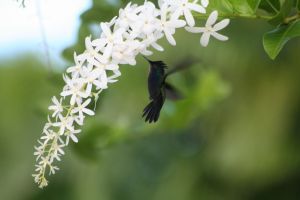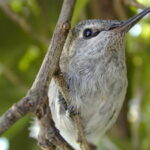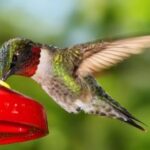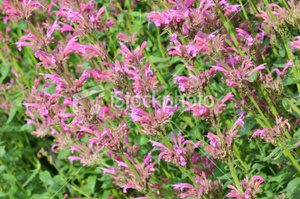It’s July, and here in Texas we are clinging to our fading memories of days when the temperature did not hit triple digits. It’s too hot to work in the garden once the sun comes up, so I spend my days in the air conditioned indoors, watching the hummingbirds that are attracted to the selection of heat tolerant plants in my garden.
Texas gardeners are lucky to have a good selection of heat tolerant plants that attract hummingbirds. All of the beautiful and colorful flowers listed below thrive in full sun and have the sort tubular flowers that will draw hummingbirds to your garden like magnets. And even though it’s the middle of summer, it’s not too late to enjoy a backyard full of jewel-like hummingbirds because all of the hummingbird attracting plants listed below do well in containers.
Almost any Salvia will attract hummingbirds to your garden.
Salvia guaranitica, also known as Black and Blue Sage, does well in heat and full sun. It is one of the few non-red flowers that reliably attract hummingbirds into my yard. Black and Blue Sage is drought tolerant as well as heat tolerant, and hummingbirds are attracted to its beautiful cobalt tubular flowers. Salvia garanitica blooms all summer long and well into the fall, which makes it a valuable flower to plant if you want to attract the hummingbirds that migrate through Texas in the late summer and fall. Salvia guaranitica is an annual in North Texas, but reseeds itself easily. It does well in containers.
Red sage is another heat tolerant plant that reliably attracts hummingbirds. There are two types of heat tolerant red sage to consider: salvia greggii and salvia coccinea. Both species feature tubular red blooms that hummingbirds love. Salvia coccinea is also known as Texas Sage, or Hummingbird Sage. A cultivar popular among hummingbirds and gardeners alike, is Lady in Red. It is an annual in North Texas, but reseeds itself easily. Texas Sage is a particularly hardy hummingbird plant, and like a true Texas native, it does not wilt in the full Texas sun.
Salvia greggii is a hummingbird attracting plant also known as Mountain Sage. It does well with only morning sun, and is very heat tolerant. Mountains Sage does not bloom until later in the summer, which makes it a good choice for attracting hummingbirds as they migrate through Texas to their winter homes in Mexico and Central America.
A final type of heat tolerant sage that attracts hummingbirds is the relatively new s. greggii cultivar Scarlett O’Hara. I have not planted it myself, but I have heard from friends that its bright red flowers are good at attracting hummingbirds and that it tolerates the Texas heat quite well.
Hummingbirds love Lantana camera.
Lantanas attract hummingbirds like crazy. Aside from being heat tolerant, Lantanas are ridiculously easy to grow and bounce back from periods of drought with no apparent problems. Lantanas also look lovely in containers, where the hummingbirds love to work over their beautifully trailing vines.
My Lantanas have variagated blooms of bright yellow, orange and red, and the hummers appear to be drawn to each color equally. Lantanas are one of my very favorite hummingbird attractors. Lantanas also attract butterflies.
Plant some Pentas.
Of all the flowers in my hummingbird garden, hummers seem to love Penta lanceolata most of all. I love them, too, because Pentas are heat tolerant, drought tolerant and almost impossible to kill. Any plant that can thrive in the stifling heat of July and August, and still be around to attract hummingbirds as they migrate through Texas in the fall is a winner in my book! Pentas are available in colors ranging from white to dark magenta. Also known as Egyptian Star Flower, the darker pink and reddish shade of Pentas attract the most hummingbirds. Butterflies are attracted to Pentas, too.
As I final note, although I live on the border of Zone 7 and Zone 8, the hummingbird attracting plants listed above can easily thrive elsewhere.
My Sources and How to Find Out More:
The plants recommended above are derived from my Personal Experience as a North Texas hobbyist gardener with a penchant for hummingbirds.
When we first bought our house in North Texas and I first started gardening to attract hummingbirds, I found the following two sources invaluable, and I still consult them all the time, for all sorts of reasons.
Neil Sperry’s GARDENS. Neil Sperry is the high priest of Texas horticulture. Ignore his advice at your own risk.
Dave’s Garden is an excellent source of information about all sorts of plants, complete with personal recommendations and opinions from gardeners all over the world.
Finally, if you live in Texas, don’t forget about The Texas Department of Agriculture.
To read more by this author, please click here.





